Abstract
The standard methodology for the assessment of cultural heritage significance relies on hindsight, with a passage of time elapsed between the creation of the site or object and its assessment. There are, however, cases where heritage significance is instant (e.g., sites associated with the first Moon landing). This paper argues that hindsight will not be required to determine that the COVID-19 pandemic will come to be considered as a significant historic event, as COVID-19 has already manifested itself as a social, cultural and economic disruptor on a global scale with a mortality in the millions. Heritage professionals have the unique opportunity to assess and document places and structures associated with the pandemic, that are poised to be worthy of a heritage listing in the near future, while they are still in use and function as intended. This paper discusses the nature of the sites and structures and explores possible management approaches to safeguard evidence of the pandemic for future generations.
1. Introduction
Soon after its existence became public in late January 2020, COVID-19, the disease caused by the severe acute respiratory syndrome coronavirus 2 (SARS-CoV-2) [1], rapidly developed into a global pandemic affecting every continent. At the time of writing, several countries have experienced a second, third and even a fourth wave of infections [2].
At each national level, and even at a sub-national level, governments engaged in measures to curb or at least slow the progress of COVID-19 and to ensure that the public health system was not overwhelmed by cases requiring hospitalization. The first involved, to various degrees and duration, the reduction of international arrivals to repatriation flights, limitations to domestic travel, the temporary shut-down of non-essential businesses, and the restriction of human movement during periods of “lockdown” [3,4]. The second involved the stockpiling of personal protective equipment (PPE) [5,6] and medical apparatuses such as ventilators [7], the development and implementation of social distancing and hygiene control measures [8], as well as the development of temporary hospital, treatment and testing facilities and temporary movement control structures (this paper).
There is a growing body of literature that comments on the impact of COVID-19 and the associated restrictions on gatherings and people’s movement on exhibitions [9], performances [10,11], museums [12,13], heritage conferences [14], employment conditions of heritage professionals [15], heritage tourism [16,17], library use [18], historic gardens [19], heritage soundscapes [20,21] and cultural festivals [22]. While they describe the effects of the pandemic on cultural industries, these approaches are purely retrospective. While the impact of the pandemic is still immediate and its overall consequences are not yet clear, other industries have given thought to the post-COVID future make-up of studying [23], working [24], living [25], commuting [26], tourism [27,28], urban design [29] and public spaces [30].
To date, little consideration has been given to the heritage of the COVID-19 pandemic. In the curatorial sphere, some museums have begun to collect items in their remit [31,32,33], with one paper positing that the social and economic impact of COVID-19 will be the focus of public exhibitions in the future and examining what material culture and other ‘artefacts’ should be collected now in order to provide future curators with a choice of items to display and interpret [34] and also a study documenting and detailing Australian examples of COVID-19-related material culture [8].
Cultural heritage planning, whether it is top-down or bottom-up [35], relies on the principle of hindsight. In common usage, some passage of time must have elapsed to adequately assess the cultural significance of a heritage place, structure or object [36,37,38]. In some instances, however, heritage significance can be instant. A good example are the objects and places (both on Earth and on the Moon) associated with the human landing on the Moon which gained instant heritage the moment that Neil Armstrong stepped on the lunar surface [39,40].
With its rapid spread and cross-sectorial impact, the COVID-19 pandemic has proven to be a social and economic disruptor on a global scale not seen since the Spanish flu pandemic of 1918–19 that cost between 17.4 and 50 million lives [41]. At the time of submission (on 7 August 2021), 216.4 million people had been infected with COVID-19 on all continents in all but seven countries, with a global death toll of 4.51 million [42].
There can be no doubt that the COVID-19 pandemic is a historically significant event and that heritage sites associated with and interpretive of this event will be worthy of listing in due course. Unlike standard heritage approaches where sites have diminished in number or integrity during the time interval between the event and the commencement of assessment, in the case of COVID-19, we have the ability to identify and assess sites as they are still functioning and make decisions about their heritage futures.
Eighteen months after the formal naming of the then novel virus (SARS-CoV-2) and then naming it the disease it causes (COVID-19) [1], this paper will examine the nature and range of cultural sites associated with the COVID-19 pandemic, its management and containment.
The paper both conceptualizes the heritage significance of these essentially ephemeral sites, discusses their documentation and will posit a framework for managing their heritage significance. In order to adequately exemplify aspects of these temporary sites, this paper is unashamedly rich in images, which provide documentation in their own right.
2. Materials and Methods
This paper employs a mixed methods methodology, encompassing standard literature survey, document analysis and lived experience. The discussion of the appearance of several temporary structures during the COVID-19 pandemic is derived from reporting and visual portrayal in the media, and augmented by lived experience observations, both personal and by fellow residents, by virtue of the author experiencing the pandemic and being a participant (as client) of some of the activities carried out in these facilities, such as testing and vaccination.
The sites illustrated and analyzed in this paper were all within the range of the author’s travels during 2020 and the first half of 2021, and thus are confined to south-eastern Australia. Unless stated otherwise, all images were taken by the author.
3. Cultural Sites Associated with COVID-19
The cultural heritage sites associated with the COVID-19 pandemic comprise purpose-built permanent structures and sites, as well as temporary structures such as facility extensions and pop-up testing and vaccination sites, comprised of temporary shelters or mobile vans.
3.1. Permanent Structures and Sites
As the epidemic progressed from country to country, and as infection rates increased in affected countries, fears emerged that public health systems would be soon overwhelmed [43]. In response, the capacity of hospital beds was rapidly expanded, with divergent approaches taken by different countries. Some used existing facilities such as naval hospital ships, [44] or acquired horizontally stratified motels to serve as overflow isolation wards [45]. Others rapidly erected entire hospital complexes (below), while most others established and readied temporary field hospitals in community centers/halls [46], exhibition and convention centers [47,48,49], concert halls [50] and even car ferries [51]. Examples of these come from countries as diverse as Italy [50], El Salvador [49] and Brazil [52]. Exhibition centers were also repurposed as large-scale, drive through COVID testing stations (Figure 1) while vacant supermarkets served as vaccination centers (Figure 2).
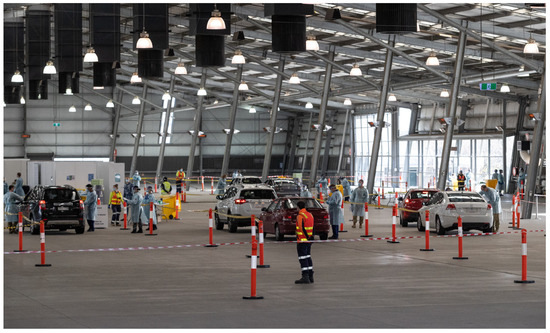
Figure 1.
COVID-testing in a repurposed structure Building 1, Exhibition Pavilion at Melbourne Showgrounds July 2020 (Image courtesy of the Royal Agricultural Society of Victoria).
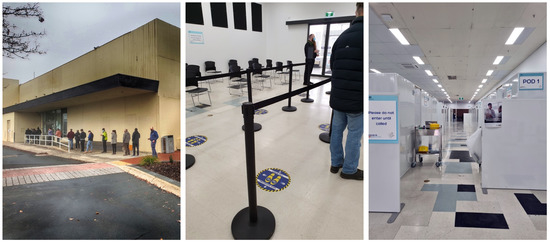
Figure 2.
Infrastructure repurposed as a COVID vaccination hub. Former supermarket, High Street, Wodonga (June 2021).
In China, the projected demand for hospital beds was met by the rapid construction of entire hospital complexes, as was the case in Wuhan (Hubei Province, China) when 1000-bed and 1500-bed field hospitals were erected in 9 days (Huoshenshan) and 12 days (Leishenshan), respectively, facilitated by a modular design of container-type prefabricated units using steel framing with steel-glass sandwich paneling [53,54,55]. While more durable and solid than the temporary structures discussed in the following section, the Huoshenshan/Leishenshan designs are also stop-gap solutions with an unspecified, but medium-term life-span, which is shorter than standard hospital construction.
In response to the pandemic, the City of Madrid (Spain) erected the dedicated 1000-bed Nurse Isabel Zendal Hospital, which was erected as a permanent structure in 100 days [56].
Cemetery Extensions
While most of these structures are temporary (short- or medium-term) and thus essentially ephemeral sites, countries with a high mortality rate had to contend with a high number of burials. In some countries, such as in Iran [57] or Yemen [58], this manifests itself in a horizontal stratigraphy of burials within the cemeteries.
3.2. Temporary Structures and Sites
Due to both its rapid onset and rapid spread, the COVID-19 pandemic forced public health systems to adapt their operations. Not only did it require the adaptation of existing facilities to prevent transmission of the virus to hospital and care facilities, but it also required the rapid deployment of mass screening and mass vaccination facilities. Most countries were caught unprepared for the unprecedented demand and had to resort to ad hoc developments. By the latter part of 2020, numerous design options had been deployed and, to some degree, evaluated, leading to the publication of design guidelines such as those by the Network for Regional Healthcare Improvement and the Design Institute for Health in the U.S.A. [59,60], private marquee suppliers, [61,62] or the New South Wales Department of Health in Australia [63].
3.2.1. Temporary Emergency Hospitals
Designs for temporary, emergency accommodation in disaster settings had been developed by the Australian company Humanihut. The modular system is comprised of single-room units with collapsible walls that can be delivered as sets of six in standard shipping containers [64]. That system was adapted into a containerized medical facility that could be deployed as a self-contained pop-up hospital [65].
Common were the erection of tent-based field hospitals drawing on preexisting military field hospitals or ad hoc designed facilities made from pre-existing, repurposed facilities (such as large pop-up tents). These were erected in sports stadiums [47,66], parking lots [67] and public parks (e.g., Central Park, New York, NY, USA) [46]. Examples for these come from countries as diverse as Argentina [66], Brazil [66], France [66] and India [68].
These temporary field hospitals were mothballed when demand declined and reactivated when required [69]. Indeed, most of the emergency facilities erected in the USA, between March and April 2020 were stood down in May 2020 [70]. As ephemeral sites, they can eventually be dismantled or repurposed back to their original use as stringent lockdown measures brought about the required reduction in hospitalizations.
3.2.2. Temporary Facility Extensions
In addition to the development and deployment of large hospital facilities, a plethora of smaller structures were erected. During the height of the pandemic, public health systems responded with a range of identification and containment measures, which required the erection of temporary structures. For example, the need to intercept potential COVID-19 carriers from unwittingly infecting other patients or medical staff, forced many hospitals to erect temporary structures that acted as containment barriers by identifying and, if required, isolating infected patients (and their carers/relatives) (Figure 3).
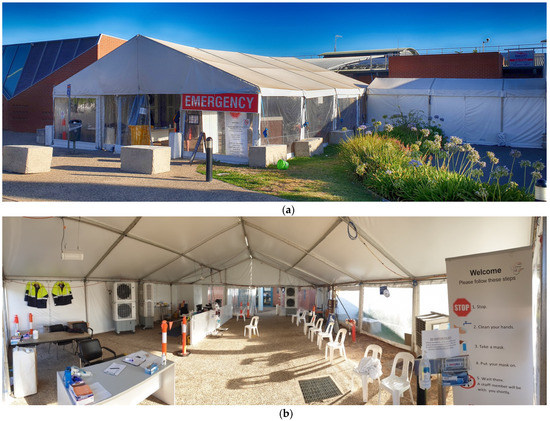
Figure 3.
Temporary infrastructure at the Emergency Department of Albury Base Hospital (January 2021): (a) Exterior; (b) Interior.
3.2.3. Temporary Testing Facilities
The need for wide-spread testing for coronavirus infections led to pop-up testing stations which led to the rapid development and deployment of temporary facilities, including pop-up testing stations. These were pioneered in South Korea [71] and soon after, found deployment in other countries, such as the USA [72] and Australia [73] as early as March 2020.
Such testing stations were established in community centers, church halls and show grounds (Figure 4) [74]. Similar facilities were utilized as vaccination hubs (Figure 3). Given the risk of aerosol transmission, as well as the need to speed up the sample collection process, temporary, drive-through stations were set up on unused public facilities, road sides and parking lots using rented commercial marquees, work-site caravans as well as existing mobile drug-testing buses (Figure 5 and Figure 6). All of these temporary facilities were eventually dismantled and removed or repurposed back to their original use once demand decreased. They could be readily re-established in a similar configuration when demand re-arose.
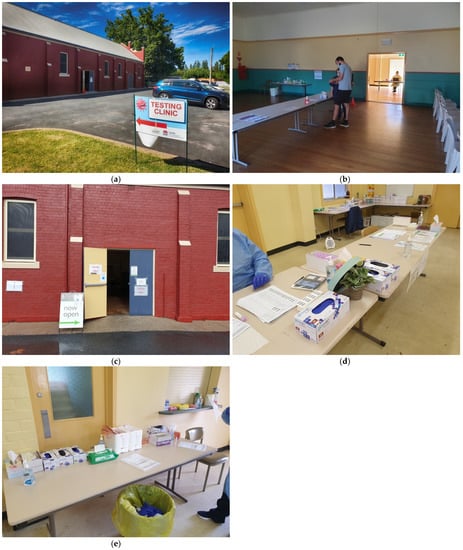
Figure 4.
Infrastructure repurposed for COVID testing. School of Arts (built 1910) (Lavington, NSW): (a) Exterior; (b) interior ((a–b) December 2020); (c) Signage; (d) Registration; (e) Sampling ((c–e) July 2021).
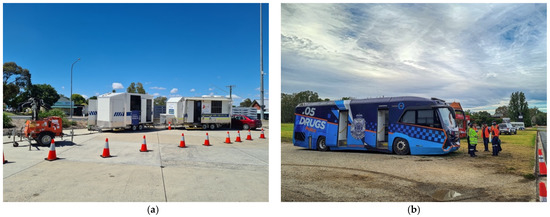
Figure 5.
Examples of temporary infrastructure for COVID testing: (a) Caravans (Tarcutta, NSW); (b) Drug-testing bus (Wodonga, Victoria) (all January 2021).
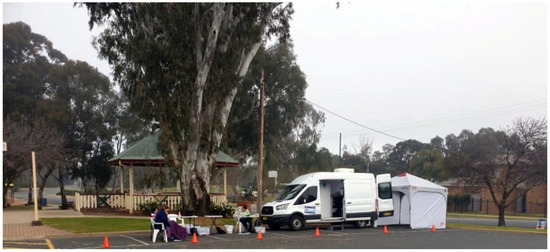
Figure 6.
Example of a mobile COVID-testing facility at Moama (Photo: Murrumbidgee Local Health District).
The testing facilities were either erected in the open (Figure 7, Figure 8 and Figure 9) or inside disused warehouses [59] and exhibition centers (Figure 1). In the Australian setting, drive-through testing facilities were favored over walk-up facilities, even though walk-up facilities were provided in some areas to service residents in high-density areas. To increase the throughput of testing, the process was broken up into sections, with registration of personal details occurring prior to entering the covered testing facility (Figure 9).
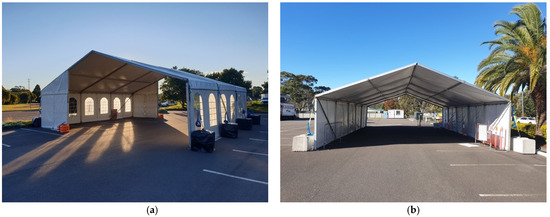
Figure 7.
Examples of temporary infrastructure for COVID testing: (a) Canval, NSW; (b) Donaylson, NSW) (both June 2012).
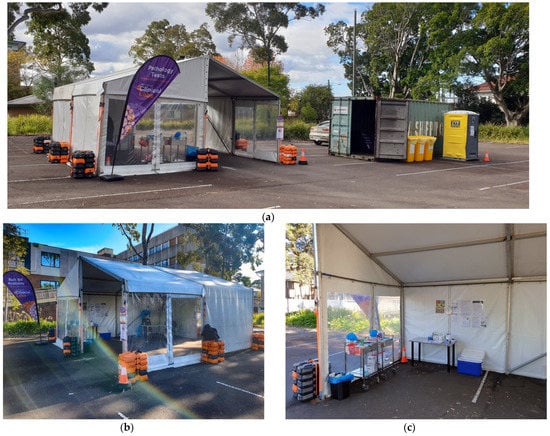
Figure 8.
Examples of temporary infrastructure for COVID testing at Hornsby (June 2021).
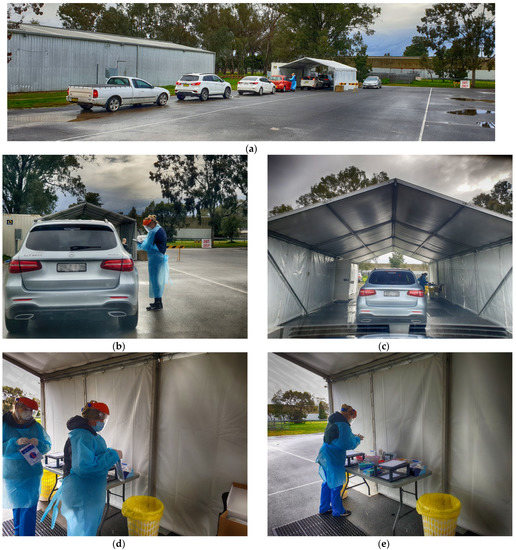
Figure 9.
Examples of temporary infrastructure for COVID testing at Albury (July 2021).
In the Australian setting, the infrastructure erected as temporary testing facilities consisted in its entirety of standard rental equipment, including commercial marquees and tents usually used for events such as weddings and receptions; traffic control barriers and traffic cones, as well as trailer-mounted lights for facilities that operated 24 h a day, such as testing stations for interstate truck drivers (Figure 4A). While the majority of the marquees are white heavy-duty PVC structures with solid sides, some COVID-testing sites utilized marquees with clear window inserts, which are, during non-pandemic times, favored by receptions and weddings (Figure 5A). It is possible that the choice of marquee design was governed by availability.
In addition, the testing stations contained smaller elements, in particular, amenities for the staff, such as rented portable toilets, as well as standard plastic garden furniture, such as chairs and folding tables.
Additional types of temporary testing facilities comprised of mobile testing vans, either repurposed police drug-testing buses (Figure 5B) or set-ups using standard panel vans with added temporary external facilities (Figure 6). These vans allowed for testing facilities to be deployed in circuits, reaching sub-regional and rural areas.
The spatial layouts of these various temporary testing facilities has been schematically illustrated in Figure 10, Figure 11 and Figure 12.
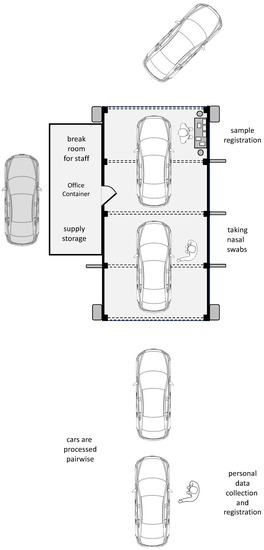
Figure 10.
Process of COVID drive-through screening.
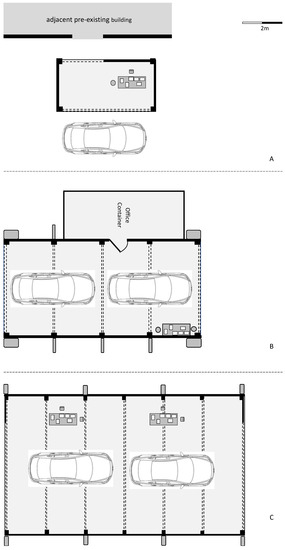
Figure 11.
Spatial layout of three temporary drive-through COVID screening centers: (A,B) Albury; (C) Canwal.
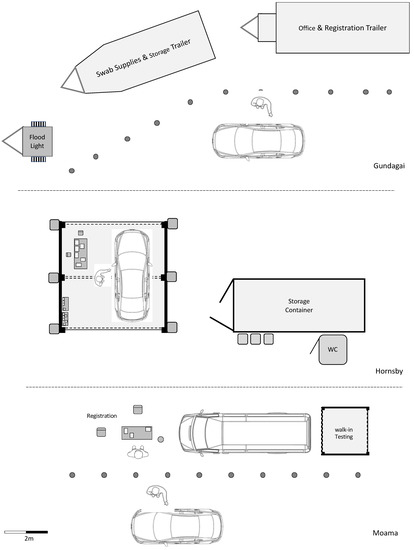
Figure 12.
Spatial layout of three temporary drive-through COVID screening centers.
3.2.4. Temporary Border Control Stations (‘Roadblocks’)
In some countries, such as Australia, borders between internal administrative jurisdictions were closed for all non-essential travel [75,76] with substantive impacts on border communities [77]. The COVID-19-related border closures and associated controls between the Australian states of NSW and Victoria, for example, lasted from 8 July until 22 November 2020 (initiated by NSW) [75,78] and between 1 January until 17 February 2021 (initiated by Victoria) [79,80]. These were the first such closures since the influenza pandemic in 1919 [81].The enforcement of these border closures occurred with roadblocks and temporary border control stations, accompanied by associated signage. In the Australian setting, the infrastructure erected as temporary border controls consisted in its entirety of standard rental equipment, such as marquees and tents, traffic control barriers as well as trailer-mounted variable message signboards, flood lights and CCTV cameras (Figure 13, Figure 14 and Figure 15). The control stations were erected on the road, limiting and directing traffic flow to multiple permit and license check positions.
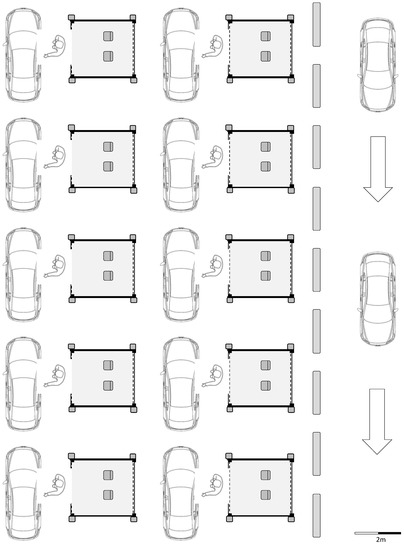
Figure 13.
Spatial layout of a border control at Albury, erected by the NSW police service.
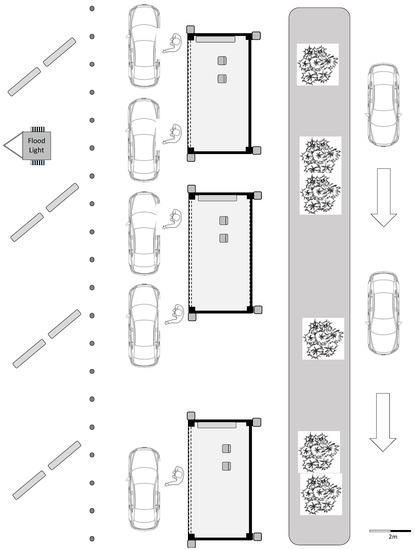
Figure 14.
Spatial layout of a border control at Wodonga, erected by the Victorian police service.
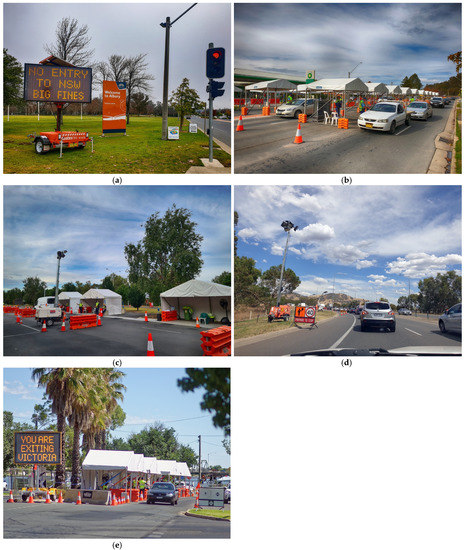
Figure 15.
Temporary infrastructure for border controls between New South Wales and Victoria (Australia): (a) Trailer-mounted variable message signboards; (b) Open-sided marquees; (c) Traffic control barriers and enclosed marquees; (d) Trailer-mounted lights; (e) Open-sided marquees and trailer-mounted variable message signboards. Restrictions for Victorian residents: (a) Total border closure, 7 July 2020; (b) Travel permit checks, 9 September 2020 (both Wodonga Place, Albury, NSW). Restrictions for New South Wales residents: (c) Travel permit checks on the Lincoln Causeway, 4 January 2021; (d) Travel permit checks at the B410, 13 January 2021 (both Wodonga, Victoria); (e) Travel permit checks at Yarrawonga, 12 January 2021 ((e) Source: Wikimedia Commons).
In addition, smaller elements that were deployed included traffic cones to indicate spatial boundaries, and personal amenities for the staff, including rented portable toilets, and standard plastic garden furniture, such as chairs and folding tables (Figure 15B). When the border closures were lifted, the control stations were removed along with any surviving traces. Variable message signboards, however, often remained for a prolonged period, projecting COVID safety messages.
3.2.5. Temporary Morgues and Cremation Grounds
The high number of COVID-19-related deaths forced many hospitals in the USA to hire refrigerated trucks and semi-trailers and repurpose them as temporary morgues to be parked on the street or in hospital car parks [82,83]. Some of these still persisted in July 2021 [84]. In the United Kingdom, temporary morgues were opened in disused aircraft hangars [85] or were erected from repurposed event tents with additional insulation [86,87,88].
In India, the high number of COVID-19-related deaths caused by the Delta strain of the SARS-CoV-2 virus overwhelmed the funeral industry. In order to create additional capacity for cremations, makeshift temporary crematoria were established in hospital parking lots and public parks [89]. It is be anticipated that these sites will revert back to their original purpose once the pandemic abates.
More generally, as noted by some authors, the burial and memorialization practices of many communities have changed during the COVID-19 pandemic [90,91,92,93] with an increased use of cremations due to cost, space constraints or public health directives [94,95,96].
4. Approaches to Managing the Heritage of the Ephemeral Structures Associated with COVID-19
The standard cultural heritage management discourse posits that cultural places and assets should be preserved for the benefit of present and future generations [97], provided they are deemed to be of significance according to agreed-on criteria [98,99]. The standard methodology for the assessment of cultural heritage significance relies on hindsight [100] with a passage of time elapsing between the creation of the site or object and its assessment [101]. There are, however, cases where events are of such significance and wide-ranging cross-cultural impact that heritage significance is instant, such as the sites associated with the first Moon landing [39,102]. Given that the pandemic has already manifested itself as a social, cultural and economic disruptor on a global scale, with mortality in the millions, hindsight will not be required to determine that the COVID-19 pandemic will come to be considered a significant historic event. This provides heritage professionals with the unique opportunity to assess and document places and structures associated with the pandemic, and evaluate whether these are poised to be worthy of heritage listing in the near future, while they are still in use and function as intended.
It needs to be stressed that there cannot be a universal solution that has global applicability. The response to COVID-19 varied widely between individual countries, governed by the severity of the impact of COVID-19, the pre-existing health infrastructure, the mobility of the population and economic capacity to establish temporary infrastructure [103,104,105]. Yet, there are numerous commonalities as exemplified by the design guidelines issues by various public health agencies [59,60,63] and by a cursory perusal of online image sources such as those aggregated by Google Image Search.
The temporary testing facilities were largely constructed of rented marquees supplied by event management companies. Similarly, marquees and tents constituted the main structural element of COVID-related roadblocks. This demand by public health and law enforcement authorities offset the loss of custom when events could not be held due to social distancing requirements and controls on crowd sizes.
4.1. Temporary Sites in the Heritage Discourse
The majority of the discourse on ephemeral heritage relates to manifestations of cultural heritage in the form of paper-based ephemera [106], soundscapes [20,21], events and performances [107], street art [108], modern, non-permanent materials (such as edible art) [109], temporary art installations [110] and digital ephemera [111], including digital art [112] and projections [113].
The deployment of temporary structures and their impact on existing heritage, as well as the creation of new layers of heritage, has been examined for the art pavilions which are erected for the Venice Biennale [114]. Setting aside issues of reuse of materials, the authors, however, do not address the heritage values and management of these temporary structures past the conclusion of the Biennale.
There are, of course, a number of heritage sites that were designed as temporary and ephemeral sites, but which still exist today, largely because the host community deemed their retention desirable. Well-known examples are the Eiffel Tower in Paris, erected for the Exposition Universelle in 1899, which still exists in its original form and materials [115]. Balboa Park in San Diego contains a steel-framed, papier mâché- and gypsum-covered building originally erected for the San Diego venue of the Panama-Pacific Exposition of 1915 [116].
In some instances, such structures decayed, but were recreated because the host community placed cultural and social value on them. An example of such copy work is the Palace of Fine Arts in San Francisco. Built in 1964–1974, the structure is a concrete and stucco replica of a steel-framed, wood- and gypsum-clad structure that had also been erected for the Panama-Pacific Exposition of 1915 [117].
Indeed, the fate of many structures erected by various nations for the numerous international exhibitions of the late nineteenth and early twentieth century is an example of the treatment of ephemeral structures. Most of them have been demolished and have made way for competing development [118].
4.2. Managing the Heritage of the Ephemeral Structures Associated with COVID-19
The range of structures associated with COVID-19 has been summarized in Table 1. The majority of these are ephemeral.

Table 1.
Ephemeral structures associated with COVID-19 and their significance.
Most of the temporary structures and facilities associated with the COVID-19 pandemic were erected in public or private spaces, that in non-pandemic times, either fulfilled a different function (such as repurposed buildings) that were sequestered from common and established use during (part of) the pandemic (such as road ways blocked off for border controls or parking lots), or that, at the time, requisition were temporarily without function, but for which future uses have been earmarked (such as open spaces for building sites). Therefore, once the imperative of COVID-19-related use abated, these spaces returned to their prior state. A preservation of the temporary COVID structures in place is both impractical and, once stripped of the processual components that designate the site a COVID testing space, for example, are also meaningless. When considering a COVID-testing site, for example, it is the conglomeration of individually insignificant, but eminently moveable elements that creates a significant whole. Removal of some or most of these components reduces the site to a meaningless shelter structure. Thus, preservation in place, let alone unchanged, is both impractical and conceptually illusionary.
This then implies the cultural heritage significance of these ephemeral sites rests in their documentation. Some evaluative work, considering the operation of emergency COVID-19 hospitals, has been published from China [119,120], Italy [50] and Spain [48]. While not adequate in terms of cultural heritage assessment, such studies provide contextual information on selected structures. While early conceptual papers exist on the topic [121,122] and while preliminary observations of operations have been published [72,123,124], evidence-based reviews of the operations and logistics of COVID-19-testing centers are rare at the time of writing [122].
The standard cultural heritage management approach to such ephemeral, but significant sites, structures and events has primarily rested in the documentation of their visual appearance [125,126,127] while other documentation approaches are mooted but not explored [110].
A more holistic documentation for each ephemeral COVID-related site should be portfolio-based, comprised of a range of media and types of evidence. This should include:
- (i)
- documents related to site planning and equipment procurement, including the underlying rationale for the size and type of marquee chosen;
- (ii)
- documentation of the actual final, spatial arrangement of the facility;
- (iii)
- documents related to operations of the site, including operating hours, staff rostering and provision of amenities, patient/client statistics, sample collection protocols and bio-waste/personal protective equipment disposal routines;
- (iv)
- visual documentation of the testing process, both in still and audio-visual imagery;
- (v)
- the select collection of operation-specific items such as forms and testing kits;
- (vi)
- the collection of media items related to the set-up, operation and public reception of the site and
- (vii)
- the collection and audio-visual recording of a wide range of eye-witness accounts from the collections’ staff and from clients utilizing the testing facility, which should cover the process itself but also the associated experiences.
While eye-witness accounts/oral history are important for all heritage sites as they exemplify the cultural heritage values associated with the historic and social context of a given site, this is particularly important for these ephemeral COVID-19-related sites. Given the short-term and ad hoc nature of the sites, staff are drawn from or seconded by various health providers on a non-permanent basis, resulting in different perceptions and experiences.
Elsewhere, the author has advocated for a proactive collections regime of COVID-19- related ephemera, such as examples of signage, social distancing markers, hand sanitizer stations and personal protective equipment (PPE) [34]. From both a cultural heritage management and museum perspective, it would be advantageous to collect one such drive-through testing facility, including all ephemera from PPE to paper forms and ad hoc furnishing. If accompanied by full documentation as discussed above, this would allow for a future interpretation of the realities of 2020–2021.
5. Conclusions
Together with ubiquitous signage, hand sanitizer stations and discarded or lost personal protective equipment [8,34], the temporary COVID-testing centers, vaccination hubs and hospital extensions have come to define the tangible manifestation of the COVID-19 pandemic. The infrastructure erected for COVID testing, vaccination and treatment, as well as for the temporary storage and subsequent disposal of the associated fatalities, is not only comprised of ephemeral structures, but is also erected on land sequestered from other uses. Coupled with the non-rigid nature of most facilities, the emergency hospital builds being an exception, these structures cannot be preserved as heritage items. Thus, they need to be extensively documented while still in operation, with a clear collections and documentation strategy once these structure become obsolete.
Funding
This research received no external funding.
Institutional Review Board Statement
Not applicable.
Informed Consent Statement
Not applicable.
Data Availability Statement
Not applicable.
Acknowledgments
Conflicts of Interest
The author declares no conflict of interest.
References
- WHO. Naming the Coronavirus Disease (COVID-19) and the Virus That Causes It. Available online: https://www.who.int/emergencies/diseases/novel-coronavirus-2019/technical-guidance/naming-the-coronavirus-disease-(covid-2019)-and-the-virus-that-causes-it (accessed on 10 August 2020).
- Ritchie, H.; Ortiz-Ospina, E.; Beltekian, D.; Mathieu, E.; Hasell, J.; Macdonald, B.; Giattino, C.; Roser, M. Coronavirus (COVID-19) Cases. Our World in Data. Available online: https://ourworldindata.org/covid-cases (accessed on 25 January 2021).
- Moloney, K.; Moloney, S. Australian Quarantine Policy: From centralization to coordination with mid-Pandemic COVID-19 shifts. Public Adm. Rev. 2020, 80, 671–682. [Google Scholar] [CrossRef] [PubMed]
- Chinazzi, M.; Davis, J.T.; Ajelli, M.; Gioannini, C.; Litvinova, M.; Merler, S.; y Piontti, A.P.; Mu, K.; Rossi, L.; Sun, K. The effect of travel restrictions on the spread of the 2019 novel coronavirus (COVID-19) outbreak. Science 2020, 368, 395–400. [Google Scholar] [CrossRef] [PubMed] [Green Version]
- Kaliya-Perumal, A.-K.; Kharlukhi, J.; Omar, U.F. The second wave of COVID-19: Time to think of strategic stockpiles. Can. J. Public Health 2020, 111, 486–487. [Google Scholar] [CrossRef]
- Mehrotra, P.; Malani, P.; Yadav, P. Personal protective equipment shortages during COVID-19—Supply chain–Related causes and mitigation strategies. JAMA Health Forum 2020, 1, e200553. [Google Scholar] [CrossRef]
- Ranney, M.L.; Griffeth, V.; Jha, A.K. Critical supply shortages—the need for ventilators and personal protective equipment during the COVID-19 pandemic. N. Engl. J. Med. 2020, 382, e41. [Google Scholar] [CrossRef] [PubMed]
- Spennemann, D.H.R. Collecting COVID-19 Ephemera: A photographic documentation of examples from regional Australia. Institute for Land, Water and Society Report 143; Institute for Land, Water and Society, Charles Sturt University: Albury, Australia, 2021. [Google Scholar]
- Hoffman, S.K. Online Exhibitions during the COVID-19 Pandemic. Mus. Worlds 2020, 8, 210–215. [Google Scholar] [CrossRef]
- Burke, V.; Jørgensen, D.; Jørgensen, F.A. Museums at home: Digital Initiatives in Response to COVID-19. Nor. Mus. 2020, 6, 117–123. [Google Scholar]
- Manderson, L.; Levine, S. COVID-19, risk, fear, and fall-out. Med Anthropol. 2020, 39, 367–370. [Google Scholar] [CrossRef]
- Kist, C. Museums, Challenging Heritage and Social Media During COVID-19. Mus. Soc. 2020, 18, 4. [Google Scholar] [CrossRef]
- Agostino, D.; Arnaboldi, M.; Lampis, A. Italian state museums during the COVID-19 crisis: From onsite closure to online openness. Mus. Manag. Curatorship 2020, 35, 362–372. [Google Scholar] [CrossRef]
- Carman, J.; Turek, J. Special Editorial: WAC in the Time of Coronavirus. Archaeologies 2020, 16, 1–22. [Google Scholar] [CrossRef]
- Hoggarth, J.A.; Batty, S.; Bondura, V.; Creamer, E.; Ebert, C.E.; Green-Mink, K.; Kieffer, C.; Miller, H.; Ngonadi, C.; Pilaar Birch, S.E. Impacts of the COVID-19 Pandemic on Women and Early Career Archaeologists. Heritage 2021, 4, 93. [Google Scholar] [CrossRef]
- Flew, T.; Kirkwood, K. The impact of COVID-19 on cultural tourism: Art, culture and communication in four regional sites of Queensland, Australia. Media Int. Aust. 2020, 178, 1329878X20952529. [Google Scholar] [CrossRef]
- Licata, M.; Larentis, O.; Tesi, C.; Fusco, R.; Ciliberti, R. Tourism in the Time of Coronavirus. Fruition of the “Minor Heritage” through the Development of Bioarchaeological Sites—A Proposal. Heritage 2021, 4, 42. [Google Scholar] [CrossRef]
- Tammaro, A.M. COVID 19 and Libraries in Italy. Int. Inf. Libr. Rev. 2020, 52, 216–220. [Google Scholar] [CrossRef]
- Hodor, K.; Przybylak, Ł.; Kuśmierski, J.; Wilkosz-Mamcarczyk, M. Identification and Analysis of Problems in Selected European Historic Gardens during the COVID-19 Pandemic. Sustainability 2021, 13, 1332. [Google Scholar] [CrossRef]
- Parker, M.; Spennemann, D.H.R. Anthropause on audio: The effects of COVID-19 pandemic on church bell ringing in New South Wales (Australia). J. Acoust. Soc. Am. 2020, 148, 1–5. [Google Scholar] [CrossRef]
- Spennemann, D.H.R.; Parker, M. Hitting the ‘Pause’ Button: What does COVID tell us about the future of heritage sounds? Noise Mapp. 2020, 7, 265–275. [Google Scholar] [CrossRef]
- Parker, M.; Spennemann, D.H.R. Stille Nacht: COVID and the ghost of Christmas 2020. Heritage 2020, in press. [Google Scholar]
- Neuwirth, L.S.; Jović, S.; Mukherji, B.R. Reimagining higher education during and post-COVID-19: Challenges and opportunities. J. Adult Contin. Educ. 2020, 1477971420947738. [Google Scholar] [CrossRef]
- Kramer, A.; Kramer, K.Z. The potential impact of the COVID-19 pandemic on occupational status, work from home, and occupational mobility. J. Vocat. Behav. 2020, 119, 103442. [Google Scholar] [CrossRef]
- Spennemann, D.H.R. Residential Architecture in a post-pandemic world: Implications of COVID-19 for new construction and for adapting heritage buildings. J. Green Build. 2021, 16, 199–215. [Google Scholar] [CrossRef]
- Musselwhite, C.; Avineri, E.; Susilo, Y. Editorial JTH 16–The Coronavirus Disease COVID-19 and implications for transport and health. J. Transp. Health 2020, 16, 100853. [Google Scholar] [CrossRef] [PubMed]
- Haywood, K.M. A post-COVID future: Tourism community re-imagined and enabled. Tour. Geogr. 2020, 22, 599–609. [Google Scholar] [CrossRef]
- Spennemann, D.H.R.; Whitsed, R. The impact of COVID-19 on the Australian outdoor recreation industry from the perspective of practitioners. J. Sust. Tour. 2020, in press. [Google Scholar]
- Bereitschaft, B.; Scheller, D. How Might the COVID-19 Pandemic Affect 21st Century Urban Design, Planning, and Development? Urban Sci. 2020, 4, 56. [Google Scholar] [CrossRef]
- Honey-Rosés, J.; Anguelovski, I.; Chireh, V.K.; Daher, C.; Konijnendijk van den Bosch, C.; Litt, J.S.; Mawani, V.; McCall, M.K.; Orellana, A.; Oscilowicz, E. The impact of COVID-19 on public space: An early review of the emerging questions–design, perceptions and inequities. Cities Health 2020, 1–17. [Google Scholar] [CrossRef]
- Church, T. Old Court House Law Museum: Collecting during COVID-19. Brief 2020, 47, 5. [Google Scholar]
- Sullivan, N. A Stitch in Time? Craftivism, Connection and Community in the Time of COVID-19. Mus. Soc. 2020, 18, 327–329. [Google Scholar] [CrossRef]
- Laurenson, S.; Robertson, C.; Goggins, S. Collecting COVID-19 at National Museums Scotland. Mus. Soc. 2020, 18, 334–336. [Google Scholar] [CrossRef]
- Spennemann, D.H.R. Curating the Contemporary: A case for national and local COVID-19 collections. Curator Subm. under review.
- Spennemann, D.H.R. Your solution, their problem. Their solution, your problem: The Gordian Knot of Cultural Heritage Planning and Management at the Local Government Level. disP Plan. Rev. 2006, 42, 30–40. [Google Scholar] [CrossRef]
- NSW Heritage Office. Assessing Heritage Significance; NSW Heritage Office: Sydney, Australia, 2001; Volume 2. [Google Scholar]
- NSW Heritage Office. Investigating Heritage Significance, , Ed.; NSW Heritage Office, Ed.; NSW Heritage Office: Sydney, Australia, 2004. [Google Scholar]
- Andrus, P.W.; Savage, B.L.; Pope, S.D. How to Apply the National Register Criteria for Evaluation. Natl. Regist. Bull. 1998, 15, 1–60. [Google Scholar]
- Spennemann, D.H.R. The Ethics of treading on Neil Armstrong’s Footprints. Space Policy 2004, 20, 279–290. [Google Scholar] [CrossRef]
- Spennemann, D.H.R.; Murphy, G. Returning to the Moon. Heritage Issues Raised by the Google Lunar X Prize; Institute for Land, Water and Society, Charles Sturt University: Albury, Australia, 2020; p. 35. [Google Scholar]
- Spreeuwenberg, P.; Kroneman, M.; Paget, J. Reassessing the global mortality burden of the 1918 influenza pandemic. Am. J. Epidemiol. 2018, 187, 2561–2567. [Google Scholar] [CrossRef] [Green Version]
- Ritchie, H.; Ortiz-Ospina, E.; Beltekian, D.; Mathieu, E.; Hasell, J.; Macdonald, B.; Giattino, C.; Appel, C.; Rodés-Guirao, L.; Roser, M. Coronavirus Pandemic (COVID-19). Available online: https://ourworldindata.org/coronavirus (accessed on 7 August 2021).
- Cavallo, J.J.; Donoho, D.A.; Forman, H.P. Hospital capacity and operations in the coronavirus disease 2019 (COVID-19) pandemic—Planning for the nth patient. JAMA Health Forum 2020, 1, e200345. [Google Scholar] [CrossRef]
- Worlton, T.; Uber, I.; Bronaugh, S.; Liedtke, E.; Dougherty, J.; Pinkos, K.; Weimerskirch, B.; Johnson, M. USNS COMFORT (T-AH 20) Surgical Services Response to the COVID-19 Pandemic in New York City. Ann. Surg. 2020, 272, e269–e271. [Google Scholar] [CrossRef]
- Perper, R. Washington State Buys Motel for Coronavirus Quarantine. Available online: https://www.businessinsider.com/washington-state-buys-motel-for-coronavirus-quarantine-2020-3 (accessed on 10 December 2020).
- Yuan, L.; Sherryn, S.; Hu, P.; Chen, F. US Field Hospitals: A Study on Public Health Emergency Response to COVID-19. medRxiv 2020. [Google Scholar] [CrossRef]
- Fang, D.; Pan, S.; Li, Z.; Yuan, T.; Jiang, B.; Gan, D.; Sheng, B.; Han, J.; Wang, T.; Liu, Z. Large-scale public venues as medical emergency sites in disasters: Lessons from COVID-19 and the use of Fangcang shelter hospitals in Wuhan, China. BMJ Glob. Health 2020, 5, e002815. [Google Scholar] [CrossRef] [PubMed]
- Candel, F.; Canora, J.; Zapatero, A.; Barba, R.; González Del Castillo, J.; García-Casasola, G.; Gil-Prieto, R.; Barreiro, P.; Fragiel, M.; Prados, F. Temporary hospitals in times of the COVID pandemic. An example and a practical view. Rev. Esp. Quimioter. Publ. Off. Soc. Esp. Quimioter. 2021, 34, 280. [Google Scholar] [CrossRef] [PubMed]
- Bello, M.; Segura, V.; Camputaro, L.; Hoyos, W.; Maza, M.; Sandoval, X.; Serpa, M.; Coopersmith, C.M. Hospital El Salvador: A novel paradigm of intensive care in response to COVID-19 in central America. Lancet Glob. Health 2021, 9, e241–e242. [Google Scholar] [CrossRef]
- Sacchetto, D.; Raviolo, M.; Beltrando, C.; Tommasoni, N. COVID-19 surge capacity solutions: Our experience of converting a concert hall into a temporary hospital for mild and moderate COVID-19 patients. Disaster Med. Public Health Prep. 2020, 1–10. [Google Scholar] [CrossRef]
- Cremonesi, P.; Sartini, M.; Spagnolo, A.M.; Adriano, G.; Zsirai, E.; Patrone, C.; Cevasco, I.; Cristina, M.L. Transformation of a Ferry Ship into a Ship Hospital for COVID-19 Patients. Int. J. Environ. Res. Public Health 2020, 17, 8976. [Google Scholar] [CrossRef] [PubMed]
- Ribeiro, A.P.; de Matos Ferreira, K.S.; Chinelli, C.K.; Soares, C.A.P. Field hospitals to face COVID-19: Requirements and lessons learned in the design and construction of the Lagoa Barra Hospital-Brazil. Strateg. Des. Res. J. 2020, 13, 387–400. [Google Scholar] [CrossRef]
- Luo, H.; Liu, J.; Li, C.; Chen, K.; Zhang, M. Ultra-rapid delivery of specialty field hospitals to combat COVID-19: Lessons learned from the Leishenshan Hospital project in Wuhan. Autom. Constr. 2020, 119, 103345. [Google Scholar] [CrossRef]
- Chen, L.-K.; Yuan, R.-P.; Ji, X.-J.; Lu, X.-Y.; Xiao, J.; Tao, J.-B.; Kang, X.; Li, X.; He, Z.-H.; Quan, S. Modular composite building in urgent emergency engineering projects: A case study of accelerated design and construction of Wuhan Leishenshan/Leishenshan hospital to COVID-19 pandemic. Autom. Constr. 2021, 124, 103555. [Google Scholar] [CrossRef]
- Wibawa, T. China Completes Coronavirus Hospital in Wuhan in 10 days, with a Second Hospital Almost Finished. Available online: https://www.abc.net.au/news/2020-02-03/china-completes-wuhan-makeshift-hospital-to-treat-coronavirus/11923000 (accessed on 10 December 2020).
- Parra, A. Spain’s Rising Cases Give Pandemic Hospital a Second Chance. Available online: https://abcnews.go.com/Health/wireStory/spains-rising-cases-give-pandemic-hospital-chance-75337043 (accessed on 3 August 2021).
- Shelton, T. Coronavirus Mass Graves in Iran Allegedly Shown in Satellite Images as Experts Question Country’s Official Virus Figures. Available online: http://www.abc.net.au/news/2020-03-14/satellite-images-could-show-mass-coronavirus-burial-pits-in-iran/12053030 (accessed on 10 December 2020).
- Besson, E.S.K.; Norris, A.; Ghouth, A.S.B.; Freemantle, T.; Alhaffar, M.; Vazquez, Y.; Reeve, C.; Curran, P.J.; Checchi, F. Excess mortality during the COVID-19 pandemic in Aden governorate, Yemen: A geospatial and statistical analysis. medRxiv 2020. [Google Scholar] [CrossRef]
- NHRI. Design Considerations for Off-Site COVID-19 Testing Centers. Network for Regional Healthcare Improvement; NHRI: Portland, ME, USA, 2020. [Google Scholar]
- Design Institute for Health. Establishing a COVID-19 Drive-Thru Testing Site. A Human-Centered Design Guide; Design Institute for Health, University of Texas at Austin: Austin, TX, USA, 2020. [Google Scholar]
- Alaska Structures. How to Set up a Drive-Through Testing Station. Available online: https://alaskastructures.com/news/how-to-set-up-a-drive-through-testing-station/ (accessed on 3 August 2021).
- Alaska Structures. Drive-through Testing and Drive-through Vaccination Shelters. Available online: https://alaskastructures.com/products/drive-through-testing-and-drive-through-vaccination-clinics/ (accessed on 3 August 2021).
- NSW Health. Guideline for COVID-19 Screening Clinics (Drive-Through, Pop-up and Mobile Vans) H20/63265. Health Service; Operations Team, NSW Department of Health: Sydney, Australia, 2020. [Google Scholar]
- Humanihut. Emergency Management. Available online: https://www.humanihut.com/emergency-management (accessed on 3 August 2021).
- Dodd, A. Pop-up Hospital May Be Answer to Future Pandemic Needs. Available online: https://theleadsouthaustralia.com.au/industries/health-and-medical/pop-up-hospital-may-be-answer-to-future-pandemic-needs/ (accessed on 3 August 2021).
- Jeffery, A. Photos of Field Hospitals Set up around the World to Treat Coronavirus Patients. Available online: https://www.cnbc.com/2020/04/03/photos-of-field-hospitals-set-up-around-the-world-to-treat-coronavirus-patients.html (accessed on 10 December 2020).
- Business Wire. AECOM Completes Two Temporary Hospitals in Partnership with the New York City Department of Design and Construction in Response to COVID-19 Crisis. Available online: https://www.businesswire.com/news/home/20200504005169/en/AECOM-completes-two-temporary-hospitals-in-partnership-with-the-New-York-City-Department-of-Design-and-Construction-in-response-to-COVID-19-crisis (accessed on 10 December 2020).
- Singh, S.; Ambooken, G.C.; Setlur, R.; Paul, S.K.; Kanitkar, M.; Bhatia, S.S.; singh Kanwar, R. Challenges faced in establishing a dedicated 250 bed COVID-19 intensive care unit in a temporary structure. Trends Anaesth. Crit. Care 2020, 36, 9–16. [Google Scholar] [CrossRef]
- Holton, K. UK Reactivates Emergency COVID-19 Hospitals, Closes London Primary Schools. Available online: https://www.reuters.com/article/us-health-coronavirus-britain/uk-reactivates-emergency-covid-19-hospitals-closes-london-primary-schools-idUKKBN2962IW?edition-redirect=uk (accessed on 3 August 2021).
- NPR. U.S. Field Hospitals Stand Down, Most Without Treating Any COVID-19 Patients. Available online: https://www.npr.org/2020/05/07/851712311/u-s-field-hospitals-stand-down-most-without-treating-any-covid-19-patients (accessed on 3 August 2021).
- Watson, I.; Jeong, S. South Korea Pioneers Coronavirus Drive-through Testing Station. Available online: https://edition.cnn.com/2020/03/02/asia/coronavirus-drive-through-south-korea-hnk-intl/index.html (accessed on 3 August 2021).
- Shah, A.; Challener, D.; Tande, A.J.; Mahmood, M.; O’Horo, J.C.; Berbari, E.; Crane, S.J. Drive-through testing: A unique, efficient method of collecting large volume of specimens during the SARS-CoV-2 (COVID-19) pandemic. Mayo Clin. Proc. 2020, 95, 1420–1425. [Google Scholar]
- Doylestown Health. Doylestown Hospital Opens Drive-Through Testing for COVID-19. Available online: https://www.doylestownhealth.org/about/news/health-news-and-blog/doylestown-hospital-opens-drive-through-testing-for-covid-19 (accessed on 3 August 2021).
- Our CBR. EPIC: Australia’s First Drive-through Clinic. Available online: https://www.act.gov.au/our-canberra/latest-news/2021/march/how-epic-became-australias-first-drive-through-covid-19-testing-clinic (accessed on 3 August 2021).
- MHMR. Public Health (COVID-19 Border Control) Order 2020 (7 July 2020). New South Wales Gov. Gaz. 2020, 149, 3477–3485. [Google Scholar]
- NSW Spatial Services. Public Health (COVID-19 Border Control) Border Zone Map PP5307; NSW Spatial Services: Sydney, Australia, 2020. [Google Scholar]
- Whitsed, R. The NSW—Victoria Border Closure: Impacts on Workers and Alternative Scenarios—An Analysis of Census Data; Institute for Land, Water and Socity Report; Institute for Land, Water and Socity, Charles Sturt University: Albury, Australia, 2020. [Google Scholar]
- MHMR. Public Health (COVID-19 Border Control) Order (No 2) Repeal Order 2020. New South Wales Gov. Gaz. 2020, 10, 610. [Google Scholar]
- Looker, C. Public Health and Wellbeing Act 2008 Section 200. Directions from Deputy Chief Health Officer in accordance with emergency powers arising from declared state of emergency. New South Wales Border Crossing Permit Scheme Directions (No. 4). Vic. Gov. Gaz. 2021, 2021, 22–31. [Google Scholar]
- Wright, A. Chronology of Victorian Border Closures Due to COVID-19. Research Notes 4; Parliament of Victoria: Melbourne, Australia, 2021. [Google Scholar]
- Spennemann, D.H.R. “No Entry into New South Wales”: COVID-19 and the Historic and Contemporary Trajectories of the Effects of Border Closures on an Australian Cross-Border Community. Land 2021, 10, 610. [Google Scholar] [CrossRef]
- Shuster, S. “I Still Can’t Believe What I’m Seeing.” What It’s like to Live across the Street from a Temporary Morgue during the Coronavirus Outbreak. Time, 31 March 2020. [Google Scholar]
- Shah, J.P. The impact of COVID-19 on head and neck surgery, education, and training. Head Neck 2020, 42, 1344. [Google Scholar] [CrossRef]
- CNBC. NYC’s Temporary Morgue Lingers, a Reminder of Pandemic’s Pain. Available online: https://www.cnbc.com/2021/07/05/nycs-temporary-morgue-lingers-a-reminder-of-pandemics-pain.html (accessed on 3 August 2021).
- BBC News. COVID-19: Temporary Mortuary Being Used by Norwich Hospital. Available online: https://www.bbc.com/news/uk-england-norfolk-55661665 (accessed on 3 August 2021).
- Booth, R. Temporary morgues being set up across UK amid rising COVID-19 deaths. The Guardian, 19 March 2020. [Google Scholar]
- Booth, R.; Marsh, S. Temporary mortuaries in south-east England needed to cope with rising Covid deaths. The Guardian, 11 January 2020. [Google Scholar]
- BBC News. Coronavirus in London: 1300-Body Mortuary Opens. Available online: https://www.bbc.com/news/uk-england-london-55670469 (accessed on 3 August 2021).
- Aggarwal, M. India Coronavirus: Delhi Builds Makeshift Funeral Pyres in Public Parks as it Runs out of Space for Dead. The Independent. Available online: https://www.independent.co.uk/asia/india/india-delhi-pyres-public-parks-b1838649.html (accessed on 3 August 2021).
- Lowe, J.; Rumbold, B.; Aoun, S.M. Memorialisation during COVID-19: Implications for the bereaved, service providers and policy makers. Palliat. Care Soc. Pract. 2020, 14, 2632352420980456. [Google Scholar] [PubMed]
- O’Mahony, S. Mourning our dead in the COVID-19 pandemic. BMJ 2020, 369. [Google Scholar] [CrossRef]
- Corpuz, J.C.G. Commemoration of the Dead in the Time of COVID-19. Disaster Med. Public Health Prep. 2021, 1–2. [Google Scholar] [CrossRef]
- Al-Dawoody, A.; Finegan, O. COVID-19 and Islamic burial laws: Safeguarding dignity of the dead. Humanit. Law Policy 2020, 19, 2020. [Google Scholar]
- Go, M.C.; Docot, D. Fire and fear: Rapid cremations in the Philippines amidst COVID-19. Forensic Sci. Int. Synerg. 2021, 3, 100132. [Google Scholar] [CrossRef] [PubMed]
- Silva, K.T. Identity, Infection and Fear: A Preliminary Analysis of COVID-19 Drivers and Responses in Sri Lanka; International Centre for Ethnic Studies: Colombo, Sri Lanka, 2020. [Google Scholar]
- Heo, Y.J. Opinion on the practice of cremation funeral for patients who died of COVID-19. J. Korean Med Assoc. 2021, 64, 243–246. [Google Scholar] [CrossRef]
- Spennemann, D.H.R. Beyond “Preserving the Past for the Future”: Contemporary Relevance and Historic Preservation. CRM J. Herit. Steward. 2011, 8, 7–22. [Google Scholar]
- ICOMOS Australia. The Burra Charter: The Australia ICOMOS Charter for Places of Cultural Significance 2013; Australia ICOMOS Inc. International Council of Monuments and Sites: Burwood, Australia, 2013. [Google Scholar]
- Fredheim, L.H.; Khalaf, M. The significance of values: Heritage value typologies re-examined. Int. J. Her. Stud. 2016, 22, 466–481. [Google Scholar] [CrossRef]
- Spennemann, D.H.R. Conceptualizing a Methodology for Cultural Heritage Futures: From Stewardship to Futurist Hindsight. Sustainability 2021, 13, 5863. [Google Scholar] [CrossRef]
- U.S. Department of the Interior. The Secretary of the Interior’s Standards for Rehabilitation and Guidelines for Rehabilitating Historic Buildings (36 CFR 67); Technical Preservation Services, National Park Service; U.S. Department of the Interior: Washington, DC, USA, 2011.
- Spennemann, D.H.R.; Kosmer, L. Heritage sites of the US Space Program in Australia: Are we managing them adequately? QUEST-Hist. Spacefl. Q. 2005, 12, 52–64. [Google Scholar]
- Tabari, P.; Amini, M.; Moghadami, M.; Moosavi, M. International public health responses to COVID-19 outbreak: A rapid review. Iran. J. Med Sci. 2020, 45, 157. [Google Scholar]
- Kuhlmann, S.; Hellström, M.; Ramberg, U.; Reiter, R. Tracing divergence in crisis governance: Responses to the COVID-19 pandemic in France, Germany and Sweden compared. Int. Rev. Adm. Sci. 2021, 0020852320979359. [Google Scholar] [CrossRef]
- Brown, G.; Susskind, D. International cooperation during the COVID-19 pandemic. Oxf. Rev. Econ. Policy 2020, 36 (Suppl. S1), S64–S76. [Google Scholar] [CrossRef]
- Garner, A. State of the Discipline: Throwaway History: Towards a Historiography of Ephemera. Book Hist. 2021, 24, 244–263. [Google Scholar] [CrossRef]
- Heredia-Carroza, J.; Palma Martos, L.; Aguado, L.F. How to Measure Intangible Cultural Heritage Value? The Case of Flamenco in Spain. Empir. Stud. Arts 2020, 39, 149–170. [Google Scholar] [CrossRef]
- Naguib, S.A. Engaged Ephemeral Art: Street Art and the Egyptian Spring. Transcult. Stud. 2017, 2, 53–88. [Google Scholar]
- Randolph, T.; Reza, N. A New Framework for Understanding Edible Art. Studia Rosenthal. 2018, 48, 1–7. [Google Scholar]
- Kamvasinou, K. Documenting interim spaces as 21st century heritage. AMPS Proc. Ser. 2019, 15, 92–100. [Google Scholar]
- Spennemann, D.H.R. Of Great Apes and Robots: Considering the Future(s) of Cultural Heritage. Futures 2007, 39, 861–877. [Google Scholar] [CrossRef]
- Lorusso, S.; Matteucci, C.; Natali, A.; Apicella, S. Traditional and non-traditional, innovative and ephemeral materials and techniques in today’s cultural heritage. Russ. Chem. Bull. 2013, 62, 1671–1681. [Google Scholar] [CrossRef]
- Yue, A. Ambient participation, placemaking and urban screens. In Communicative Cities and Urban Space; Routledge: London, UK, 2020; pp. 163–176. [Google Scholar]
- Zorzetto, A.; Padura, A.B.; Huelva, M.M. Ephemeral architecture as medium for regenerating the historical city. The case of Venice. In Heritage 2020. Proceedings of the 7th International Conference on Heritage and Sustainable Development; Amoêda, R., Lira, S., Pinheiro, C., Eds.; Green Lines Institute for Sustainable Development: Barcelos, Portugal, 2020; pp. 717–723. [Google Scholar]
- Harriss, J. The Eiffel Tower: Symbol of an Age; Paul Elek: London, UK, 1975. [Google Scholar]
- Amero, R.W. Balboa Park and the 1915 Exposition; The History Press: Cheltenham, UK, 2013. [Google Scholar]
- Marquand, W.; Brechin, G.; Corbett, M.; Shreve, S.; Garry, V. National Register of Historic Places Inventory-Nomination: Palace of Fine Arts. National Register Number 04000659. Available online: https://npgallery.nps.gov/AssetDetail/NRIS/04000659 (accessed on 3 August 2021).
- Curralo, A.F.; Barbosa, H. Exhibition Structures: Displaying Portugal. In Back to the Future. The Future in the Past. ICDHS 10th+1 Conference, Barcelona Proceedings Book; Moret, O., Ed.; Gracmon: Barcelona, Spain, 2018; p. 367. [Google Scholar]
- Yuan, Y.; Qiu, T.; Wang, T.; Zhou, J.; Ma, Y.; Liu, X.; Deng, H. The application of Temporary Ark Hospitals in controlling COVID-19 spread: The experiences of one Temporary Ark Hospital, Wuhan, China. J. Med Virol. 2020, 92, 2019–2026. [Google Scholar] [CrossRef] [PubMed]
- Zhu, W.; Wang, Y.; Xiao, K.; Zhang, H.; Tian, Y.; Clifford, S.P.; Xu, J.; Huang, J. Establishing and managing a temporary coronavirus disease 2019 specialty hospital in Wuhan, China. Anesthesiology 2020. [Google Scholar] [CrossRef] [Green Version]
- Araz, O.M.; Ramirez-Nafarrate, A.; Jehn, M.; Wilson, F.A. The importance of widespread testing for COVID-19 pandemic: Systems thinking for drive-through testing sites. Health Syst. 2020, 9, 119–123. [Google Scholar] [CrossRef] [Green Version]
- Flynn, E.F.; Kuhn, E.; Shaik, M.; Tarr, E.; Scattolini, N.; Ballantine, A. Drive-through COVID-19 testing during the 2020 pandemic: A safe, efficient, and scalable model for pediatric patients and health care workers. Acad. Pediatrics 2020, 20, 753. [Google Scholar] [CrossRef] [PubMed]
- Ton, A.N.; Jethwa, T.; Waters, K.; Speicher, L.L.; Francis, D. COVID-19 drive through testing: An effective strategy for conserving personal protective equipment. Am. J. Infect. Control 2020, 48, 731–732. [Google Scholar] [CrossRef]
- Hill, K.; Campbell, R.; Mutch, C.; Koch, O.; Mackintosh, C. Drive-through testing in COVID-19: Experience from NHS Lothian. Clin. Med. 2020. [Google Scholar] [CrossRef]
- McClure, U.E. A conditional preservation for ephemeral sites. Chang. Time 2015, 5, 286–304. [Google Scholar] [CrossRef]
- Cooke, J. Ephemeral Traces of ‘Alternative Space’: The Documentation of Art Events in London 1995–2005, in an Art Library. Ph.D. Thesis, Goldsmiths’ College, London, UK, 2007. [Google Scholar]
- Shiell, M. Trace: An Exploration of Alternative Means of Documenting Ephemeral Environmental Art; University of Ballarat: Ballarat, Australia, 2011. [Google Scholar]
Publisher’s Note: MDPI stays neutral with regard to jurisdictional claims in published maps and institutional affiliations. |
© 2021 by the author. Licensee MDPI, Basel, Switzerland. This article is an open access article distributed under the terms and conditions of the Creative Commons Attribution (CC BY) license (https://creativecommons.org/licenses/by/4.0/).